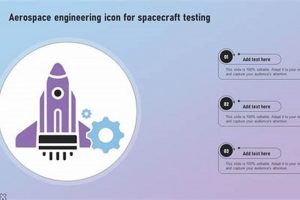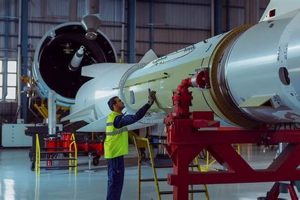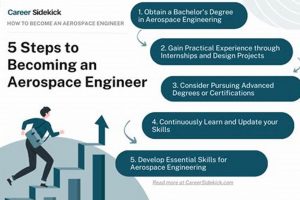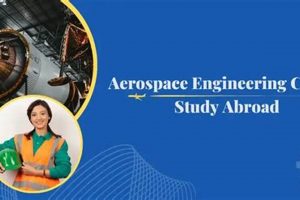Professionals seeking positions in the aircraft and spacecraft design, development, and manufacturing sectors often utilize model documents to create compelling application letters. These illustrations provide a framework for articulating relevant skills, experience, and academic achievements. A typical scenario involves a graduate applying for an entry-level design engineer role, where the sample document showcases prior internship experiences, CAD software proficiency, and project contributions. Another instance could be a seasoned engineer targeting a lead systems engineer position, relying on existing templates to highlight project management experience, team leadership capabilities, and technical expertise in areas like propulsion systems or avionics.
The advantage of using pre-existing structures lies in their ability to save time and ensure key information is presented effectively. These models serve as a guide to ensure that essential qualifications are explicitly stated and aligned with the requirements of the desired position. Historically, these examples were often circulated within university career services or among professional networks. The advent of online resources has expanded access, enabling a broader range of individuals to leverage these resources in their job search.
The subsequent sections will delve into key elements of effective application letters tailored for aerospace engineering roles, including how to structure content, showcase relevant projects, and tailor the message to specific companies and positions. Furthermore, common mistakes to avoid and best practices for creating a polished and impactful document will be discussed.
Key Considerations for Aerospace Engineering Application Letters
Crafting a compelling application letter is critical for securing aerospace engineering positions. Adhering to the following guidelines can significantly enhance the document’s impact.
Tip 1: Quantify Accomplishments: Rather than simply listing responsibilities, quantify achievements whenever possible. For example, instead of stating “Managed a team,” specify “Managed a team of five engineers to reduce development time by 15%.”
Tip 2: Highlight Relevant Projects: Emphasize projects directly relevant to the target role. For a structures engineer position, elaborate on experience with finite element analysis or composite materials design.
Tip 3: Tailor to the Specific Company: Research the company’s current projects and values. Demonstrate how qualifications align with their specific needs and strategic goals.
Tip 4: Showcase Technical Proficiency: Clearly state proficiency in relevant software and tools, such as CATIA, ANSYS, MATLAB, or Python. Provide specific examples of how these tools were used in previous projects.
Tip 5: Emphasize Teamwork and Communication Skills: Aerospace engineering inherently requires collaboration. Provide examples of effective teamwork and communication within a project setting.
Tip 6: Address the Job Description Directly: Meticulously review the job description and ensure that each required skill and experience is explicitly addressed within the application letter.
Tip 7: Maintain a Professional Tone and Format: Use a formal and professional tone throughout the document. Ensure proper grammar, spelling, and formatting to present a polished and credible image.
By incorporating these elements, the application letter becomes a powerful tool for showcasing qualifications and capturing the attention of potential employers within the competitive aerospace engineering sector.
The subsequent section will address common pitfalls to avoid when constructing an application letter for aerospace engineering positions.
1. Conciseness
In the context of application letters for aerospace engineering positions, conciseness is paramount. Recruiters often evaluate numerous applications; therefore, the ability to convey key information succinctly significantly increases the likelihood of the document being thoroughly reviewed.
- Eliminating Redundancy
Redundancy in application letters weakens the overall message and can detract from crucial details. Aerospace application letters should avoid restating information already present in the resume. Instead, the letter should elaborate on specific experiences and skills relevant to the targeted role, providing context and demonstrating how these qualifications align with the company’s needs.
- Focusing on Key Achievements
An effective, concise application letter emphasizes key accomplishments that demonstrate the applicant’s capabilities. Vague statements should be replaced with quantifiable achievements. For instance, instead of stating “Improved efficiency,” a concise statement would specify “Increased system efficiency by 12% through optimization of algorithm X.” Such specifics provide tangible evidence of the applicant’s contributions.
- Targeting the Audience
Conciseness requires a deep understanding of the target audience. Researching the company’s values, projects, and culture allows for tailoring the application letter to specifically address their needs. Generic application letters are often overlooked; a targeted approach demonstrates genuine interest and the ability to communicate effectively with a specific audience.
- Streamlining Language
Precise language is critical for achieving conciseness. Avoiding jargon and using clear, straightforward language ensures that the message is easily understood. The application letter should present a professional image while maintaining a direct and accessible tone.
In summary, conciseness in aerospace engineering application letters necessitates eliminating redundancy, focusing on key achievements, targeting the audience, and streamlining language. By adhering to these principles, the application letter becomes a powerful tool for capturing the attention of recruiters and showcasing the applicant’s suitability for the position.
2. Relevance
The utility of aerospace engineering application letter models is significantly determined by the relevance of their content to the specific position and company. A generic, untailored document risks being dismissed, while a targeted application letter demonstrates a clear understanding of the employer’s needs and values.
- Alignment with Job Description
Relevance begins with a meticulous review of the job description. The application letter should directly address each requirement, highlighting specific skills and experiences that align with the employer’s needs. For instance, if the job description emphasizes experience with computational fluid dynamics (CFD), the application letter should explicitly detail relevant CFD projects and software proficiency. Neglecting to address key requirements suggests a lack of attention to detail or a failure to understand the employer’s priorities.
- Industry Knowledge and Company Awareness
Demonstrating knowledge of the aerospace industry and the specific company is crucial for establishing relevance. The application letter should reference recent company projects, technological advancements, or strategic goals. For example, an applicant might discuss their familiarity with the company’s work on sustainable aviation or their understanding of the challenges associated with hypersonic flight. Such references demonstrate a genuine interest in the company and an awareness of its position within the industry.
- Transferable Skills and Experience
In some cases, direct experience in a specific area may be limited. In such instances, highlighting transferable skills and experience becomes critical. For instance, an applicant with experience in mechanical engineering could emphasize their knowledge of finite element analysis, materials science, or thermodynamics, demonstrating the relevance of their skills to aerospace engineering applications. Emphasizing transferable skills requires a clear articulation of how those skills can be applied to the target role.
- Project-Based Demonstration
A relevant application letter incorporates project examples that illustrate the applicant’s capabilities. The projects should be specifically chosen to align with the target position’s requirements. An applicant for a propulsion engineer role might describe their contributions to a rocket engine design project, highlighting their experience with combustion modeling or nozzle design. The project descriptions should quantify achievements and emphasize the applicant’s role in the project’s success.
The relevance of an aerospace engineering application letter is a multifaceted concept that encompasses alignment with the job description, industry knowledge, transferable skills, and project-based demonstrations. By prioritizing these elements, applicants can create application letters that effectively showcase their qualifications and increase their chances of securing an interview.
3. Quantifiable achievements
The inclusion of quantifiable achievements within model documents designed for aerospace engineering employment is not merely an aesthetic preference but a functional necessity. The inherent nature of engineering requires precise measurement and demonstrable results. Therefore, application letters lacking tangible data points risk being perceived as subjective and unsubstantiated. Quantifiable achievements provide concrete evidence of an applicant’s capabilities and impact on previous projects. For instance, instead of claiming “Improved aerodynamic efficiency,” stating “Reduced drag coefficient by 8% through redesign of airfoil geometry, resulting in a projected fuel savings of 3%” offers a far more compelling and verifiable claim. This level of detail transforms a general statement into a specific, measurable accomplishment that directly relates to the core competencies of aerospace engineering.
The effect of incorporating quantifiable metrics extends beyond mere presentation. It forces applicants to critically analyze their past experiences and identify specific contributions that can be objectively measured. This process not only strengthens the application letter but also prepares the applicant for potential technical interviews, where detailed explanations of project outcomes are often required. Consider the example of a systems engineer who, instead of stating “Managed a project effectively,” articulates “Managed a cross-functional team of 12 engineers, completing the avionics integration project 2 weeks ahead of schedule and 5% under budget, while maintaining zero critical defects.” This provides a clear indication of project management skills, adherence to deadlines, and cost-effectiveness all highly valued attributes in the aerospace industry. The absence of such quantifiable details weakens the impact of the application letter and potentially undermines the applicant’s credibility.
In summary, the connection between quantifiable achievements and effective application letters for aerospace engineering roles is undeniable. These metrics provide tangible evidence of an applicant’s skills, project impact, and overall competence. The inclusion of specific, measurable data points strengthens the application, prepares the applicant for technical interviews, and ultimately increases the likelihood of securing a position in this competitive field. Failure to incorporate quantifiable achievements represents a significant missed opportunity to showcase qualifications and demonstrate value to potential employers.
4. Technical Proficiency
Technical proficiency forms a cornerstone of effective aerospace engineering application letters. These letters serve as a primary vehicle for communicating specialized skills to potential employers. An application letter, serving as an introductory document, often necessitates an explicit detailing of competence in relevant software, hardware, and engineering principles. Technical proficiency detailed within these documents demonstrates not only competence but also the capacity to contribute effectively to an organization’s projects. For instance, explicitly stating expertise in CAD software such as CATIA or SolidWorks, alongside experience with finite element analysis tools like ANSYS, directly illustrates an applicant’s immediate value to a design team. Similarly, mentioning proficiency in programming languages such as MATLAB or Python, along with their application in areas like control systems or data analysis, provides tangible evidence of analytical capabilities.
Without detailed descriptions of technical competencies, application letters risk being perceived as lacking substance. An application letter may showcase relevant experience within the aerospace industry, but without supporting documentation with technical expertise, it fails to highlight and show off expertise, therefore failing the goal of a well-written application letter. For example, a letter that vaguely references “experience in structural analysis” is significantly less impactful than one that specifies “experience in performing static and dynamic structural analysis using ANSYS Workbench, resulting in a 15% reduction in component weight while maintaining structural integrity.” The latter statement not only demonstrates technical proficiency but also quantifies the positive impact of those skills on a specific project. Additionally, detailing the types of aerospace-specific projects undertaken, like designing composite structures for aircraft or developing control algorithms for unmanned aerial vehicles, offers concrete evidence of practical application of technical skills.
In conclusion, technical proficiency is an indispensable component of aerospace engineering application letters. These letters, serving as initial introductions to potential employers, must clearly and specifically articulate an applicant’s technical capabilities. Failure to do so risks undermining the application’s impact and diminishing the likelihood of securing an interview. An application letter’s impact may significantly affect job interviews and opportunities for candidates, as it is an early presentation of candidates.
5. Company Alignment
Company alignment represents a critical component within effective aerospace engineering application documents. The degree to which an application demonstrates understanding and integration with a company’s specific mission, values, and projects directly impacts its persuasive power. An application document, devoid of such alignment, risks appearing generic and failing to capture the attention of hiring managers. Company alignment demonstrates that the applicant has conducted thorough research and possesses a genuine interest in contributing to the organization’s unique goals. An aerospace engineering candidate who mentions their experience with sustainable aviation technologies in an application to a company that is actively pursuing eco-friendly initiatives clearly demonstrates company alignment.
The practical manifestation of company alignment can take several forms. First, an applicant should explicitly address how their skills and experience directly support the company’s ongoing projects or strategic objectives. For example, when applying to a company known for developing advanced composite materials for aircraft, an applicant should showcase their experience in composite design, analysis, and manufacturing. Second, an applicant should demonstrate an understanding of the company’s culture and values, and articulate how their personal work ethic and professional goals align with those principles. Lastly, an applicant might reference specific company achievements or innovations that resonate with their personal interests or professional aspirations. Understanding and implementing aspects relevant to company culture in the aerospace industry is a positive attribute, and can show great success in securing positions.
In summary, company alignment is not merely a superficial element but rather an integral factor in crafting a compelling aerospace engineering application. By aligning their skills, experience, and values with the specific goals and culture of the target company, applicants significantly increase their chances of making a positive impression and securing an interview. The absence of such alignment diminishes the document’s effectiveness and signals a lack of genuine interest in the organization.
6. Project demonstration
Effective applications for aerospace engineering positions hinge on the detailed demonstration of relevant projects. Aerospace engineering cover letter examples, therefore, frequently emphasize project descriptions as a means of showcasing practical skills and experience. The absence of such demonstrations weakens the application, leaving employers to infer an applicant’s capabilities. Project demonstration within these application letters is a causal factor in securing interviews and job offers. Clear, concise, and quantifiable descriptions of project involvement underscore the applicant’s ability to apply theoretical knowledge to real-world engineering challenges. For example, an applicant describing their participation in a student satellite project should detail their specific role, the technical challenges addressed, and the measurable outcomes achieved. This establishes credibility and provides concrete evidence of the applicant’s capabilities.
The specific elements of an effective project demonstration include the project’s objectives, the applicant’s role, the methodologies employed, and the quantifiable results obtained. A common approach involves highlighting projects that directly align with the target company’s areas of expertise or current projects. An applicant seeking a position in propulsion systems, for instance, should prioritize descriptions of projects involving rocket engine design, computational fluid dynamics analysis of nozzle performance, or experimental testing of combustion systems. Furthermore, clear articulation of the applicant’s individual contributions to the project is essential. Did the applicant lead a specific sub-team, develop a critical algorithm, or perform a crucial analysis? Specifying these contributions distinguishes the applicant from other team members and reinforces their unique qualifications.
In summary, project demonstration serves as a cornerstone of compelling aerospace engineering applications. The ability to effectively communicate project involvement and outcomes directly correlates with an applicant’s chances of success. Detailed descriptions, quantified achievements, and alignment with the target company’s interests are essential components of a persuasive project demonstration. While academic qualifications and technical skills are important, project experience provides tangible evidence of an applicant’s ability to apply their knowledge and contribute to real-world engineering challenges.
7. Professional presentation
Professional presentation is an indispensable element of aerospace engineering application documents. This facet encompasses not only grammatical correctness and stylistic consistency but also the strategic formatting and organization of information to maximize impact. Aerospace engineering application documents are often subjected to scrutiny by experienced recruiters and hiring managers, who value precision and attention to detail. An application exhibiting a lack of professionalism, through errors or inconsistencies, can create a negative initial impression, potentially overshadowing otherwise strong qualifications. The immediate visual impact of a well-structured, error-free application document signals competence and respect for the recipient’s time and expertise.
The manifestation of professional presentation within aerospace engineering applications extends beyond surface-level aesthetics. It encompasses the logical flow of information, the strategic use of white space to enhance readability, and the consistent application of formatting conventions (e.g., font types, headings, bullet points). Clear and concise language is also crucial, avoiding jargon or overly technical terminology that may not be universally understood. Furthermore, professional presentation includes the careful selection of language to convey enthusiasm and confidence without resorting to hyperbole or unsubstantiated claims. An example would be utilizing bullet points to display software skills and abilities, using proper spelling and grammar, and a clear and concise summary. These examples are highly sought after attributes to present in the field of aerospace engineering.
In summary, professional presentation is inextricably linked to the efficacy of aerospace engineering application documents. It serves as a visual and stylistic indicator of an applicant’s competence, attention to detail, and respect for professional standards. While technical qualifications and project experience are undoubtedly critical, a poorly presented application can undermine even the most impressive credentials. Thus, meticulous attention to grammar, formatting, organization, and language is essential for creating a compelling and effective application document.
Frequently Asked Questions
The subsequent section addresses prevalent inquiries regarding the construction of effective application letters tailored for the aerospace engineering sector. These questions and answers aim to provide clarity and guidance for individuals seeking to enhance their application materials.
Question 1: What is the recommended length for an aerospace engineering application letter?
Ideal length is generally one page. Recruiters often have limited time; brevity and conciseness are valued. Information should be prioritized, focusing on the most relevant skills and experiences for the specific position.
Question 2: Should the application letter reiterate information already present in the resume?
Avoid direct repetition. The application letter should complement the resume by providing context and elaboration on key achievements or skills. It serves as an opportunity to showcase personality and demonstrate alignment with the company’s goals.
Question 3: How important is it to tailor the application letter to each specific job application?
Tailoring is crucial. Generic application letters are often easily identified and can be detrimental to the application. Each letter should be customized to reflect the specific requirements and values of the target company and position. Researching the company’s projects and culture is essential for effective tailoring.
Question 4: What are some common mistakes to avoid when writing an aerospace engineering application letter?
Common errors include grammatical errors, spelling mistakes, lack of quantifiable achievements, vague descriptions of skills, and a failure to address the job description directly. Additionally, an overly aggressive or entitled tone can be detrimental.
Question 5: How can an applicant demonstrate technical proficiency in the application letter?
Technical proficiency can be demonstrated by listing specific software, tools, or programming languages with which the applicant is proficient. Additionally, concrete examples of how these skills were applied in previous projects can significantly enhance the impact of the letter.
Question 6: Is it appropriate to express enthusiasm for the position and company in the application letter?
Expressing genuine enthusiasm is appropriate, but it should be balanced with professionalism. Avoid excessive flattery or overly emotional language. Demonstrating a clear understanding of the company’s mission and values is a more effective way to convey interest.
These frequently asked questions provide valuable insights into crafting effective application letters for the aerospace engineering sector. By addressing these concerns and adhering to best practices, applicants can significantly improve their chances of securing an interview.
The succeeding segment will delve into real-world examples and case studies to further illustrate the principles discussed herein.
Conclusion
Aerospace engineering application letter models serve as crucial tools for professionals seeking entry or advancement within the aerospace sector. Throughout this exploration, aspects such as conciseness, relevance, quantifiable achievements, technical proficiency, company alignment, project demonstration, and professional presentation have emerged as pivotal components of an effective document. These elements collectively contribute to an application that effectively showcases qualifications and captures the attention of potential employers.
The utilization of aerospace engineering application letter models, when informed by the principles outlined herein, significantly enhances the prospects of securing desired positions. Prospective applicants are encouraged to leverage these insights to construct compelling applications that accurately reflect their capabilities and align with the specific demands of the aerospace industry, thereby maximizing their opportunities for success in this competitive field. The ongoing evolution of the aerospace landscape necessitates a continued emphasis on refining these application strategies to meet the ever-changing demands of the job market.







